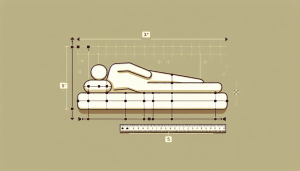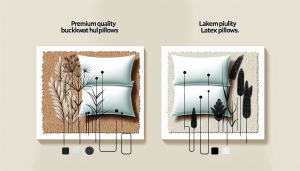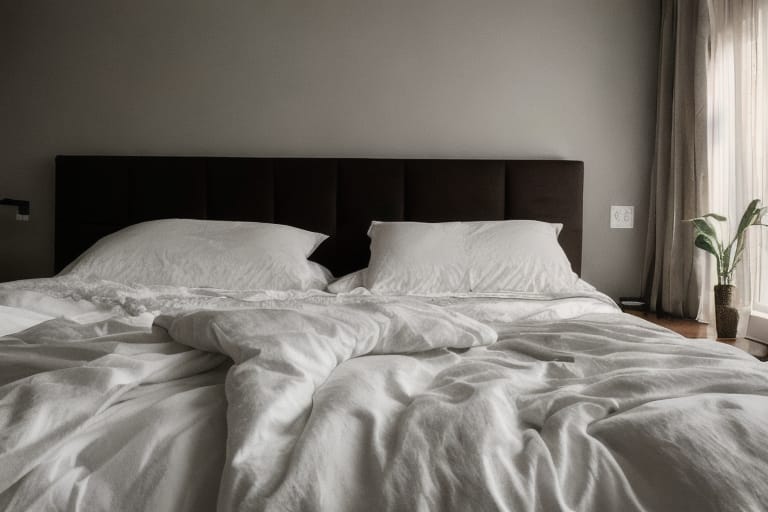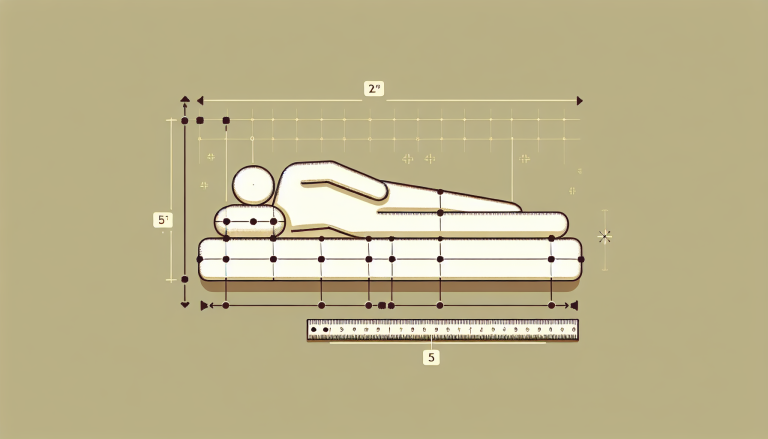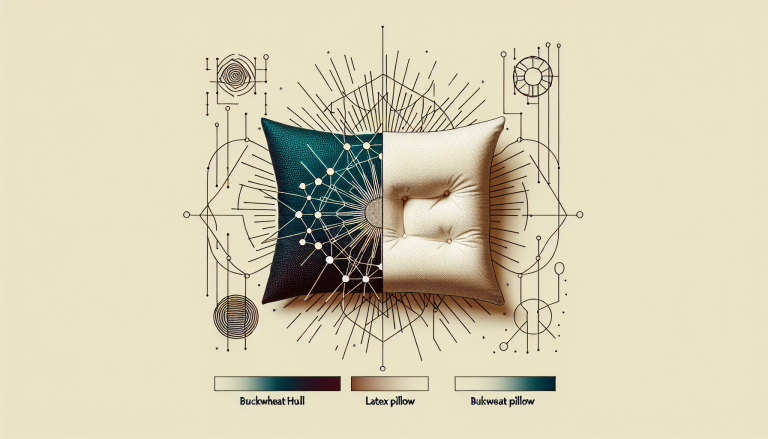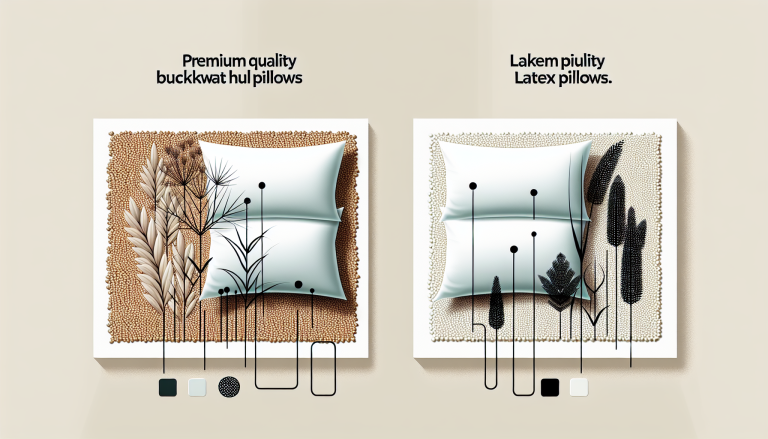Are you in search of the ultimate sleeping experience? Look no further than a fluffy down comforter! With their cloud-like softness, luxurious feel, and unbeatable warmth-to-weight ratio, down comforters are the epitome of comfort. In this comprehensive guide, we’ll explore the key factors that make a down comforter the fluffiest, helping you find the perfect one for a cozy and restful night’s sleep.
Understanding Down Comforter Fill Power
Fill power is a crucial factor in determining the fluffiness of a down comforter. It measures the loft and insulating ability of the down, with higher fill powers indicating greater fluffiness and warmth.
Definition of Fill Power
Fill power is the volume, measured in cubic inches, that one ounce of down occupies under specific testing conditions. In other words, it measures the loftiness and fluffiness of the down.
Importance of High Fill Power for Fluffiness
Higher fill powers mean that the down clusters are larger and more resilient, resulting in a fluffier and loftier comforter. Comforters with high fill powers also tend to be lightweight and breathable, as less down is needed to achieve the same level of warmth.
Typical Fill Power Ranges
Down comforters typically range from 400 to 900+ fill power. Here’s a general guide:
| Fill Power | Quality | Fluffiness |
|---|---|---|
| 400-599 | Moderate | Adequate fluffiness, less lofty |
| 600-799 | Good | Fluffy and warm |
| 800-999 | Excellent | Extremely fluffy and lightweight |
Testing Methods for Measuring Fill Power
Fill power is measured using the Lorch or Tumble Dry method, which involves placing a specific amount of down in a cylinder, compressing it with a weight, and measuring the volume it occupies. This standardized testing ensures accurate and consistent fill power ratings.
Loft and Warmth Factors
Loft and warmth are closely related to fill power and are essential factors in determining the fluffiness and coziness of a down comforter.
Relationship Between Loft and Warmth
Loft refers to the height and fluffiness of the down. Higher loft means more air is trapped within the down clusters, resulting in better insulation and warmth.
Importance of Loft for Fluffiness
A comforter with high loft will feel fluffier and more cloud-like, as the down clusters are able to fully expand and create a soft, plush surface.
Factors Affecting Loft Retention
Several factors can affect a comforter’s ability to maintain its loft over time:
- Quality of down clusters
- Baffle box construction
- Shell fabric and thread count
- Proper care and maintenance
Achieving Optimal Warmth-to-Weight Ratio
The ideal down comforter should provide ample warmth without feeling heavy or restrictive. Comforters with high fill powers and loft can achieve this balance, offering cozy warmth in a lightweight package.
Down Cluster Quality and Composition
The quality and composition of the down clusters play a significant role in determining the fluffiness and performance of a down comforter.
Difference Between Down and Feathers
Down refers to the soft, fluffy undercoat of ducks or geese, while feathers are the outer covering with quills. Down clusters are lighter, fluffier, and provide better insulation than feathers.
Importance of Down Cluster Quality
High-quality down clusters are larger, more resilient, and have better loft retention. They contribute to the overall fluffiness and longevity of the comforter.
Ethically-Sourced and Sustainable Down
When choosing a down comforter, consider brands that use ethically-sourced and sustainable down. Look for certifications like the Responsible Down Standard (RDS) or Global Traceable Down Standard (TDS) to ensure the humane treatment of ducks and geese.
Hypoallergenic Down Options
For those with allergies or sensitivities, hypoallergenic down options are available. These undergo special cleaning processes to remove allergens and dust, providing a clean and comfortable sleeping environment.
Baffle Box Construction
Baffle box construction is a key feature of high-quality down comforters, ensuring even distribution of down and maximum fluffiness.
Definition of Baffle Box Construction
Baffle box construction involves sewing vertical walls between the top and bottom layers of the comforter, creating individual boxes that keep the down evenly distributed.
Benefits for Fluffiness and Loft Retention
Baffle boxes allow the down to fully loft within each compartment, maintaining the comforter’s fluffiness and loft over time. This construction prevents the down from shifting, clumping, or creating cold spots.
Preventing Down from Shifting or Clumping
With baffle box construction, the down stays evenly distributed throughout the comforter, eliminating the need for constant fluffing and redistributing.
Comparison to Sewn-Through Construction
Sewn-through construction, while less expensive, can compress the down and create cold spots where the stitching runs through the comforter. Baffle box construction eliminates these issues, providing a fluffier and more consistent warmth.
Thread Count and Shell Fabric
The shell fabric and thread count of a down comforter play a crucial role in its overall feel, durability, and fluffiness.
Importance of High Thread Count
Thread count refers to the number of threads per square inch of fabric. Higher thread counts (300+) create a smoother, softer, and more durable shell that complements the fluffiness of the down.
Common Shell Fabric Materials
Down comforters often use high-quality cotton, sateen, or cambric for their shell fabrics. These materials are breathable, soft, and lightweight, enhancing the overall comfort of the comforter.
Down-Proof Fabrics to Prevent Down Leakage
To keep the down securely inside the comforter, look for down-proof fabrics with tightly woven threads. These fabrics prevent down from escaping through the shell, maintaining the comforter’s fluffiness and integrity.
Breathability and Moisture-Wicking Properties
Breathable and moisture-wicking shell fabrics help regulate temperature and keep you comfortable throughout the night. They allow air to circulate and wick away excess moisture, preventing clamminess and overheating.
Fill Weight and Size Options
Fill weight and comforter size are important considerations when choosing the fluffiest down comforter for your needs.
Typical Fill Weights for Different Sizes
Fill weight, measured in ounces, varies depending on the comforter size. Here’s a general guide:
| Size | Typical Fill Weight |
|---|---|
| Twin | 16-20 oz |
| Full/Queen | 22-28 oz |
| King/Cal King | 30-36 oz |
Relationship Between Fill Weight and Fluffiness
Higher fill weights generally correspond to fluffier comforters, as there is more down to create loft and insulation. However, the fill power and quality of the down also play significant roles in determining fluffiness.
Choosing the Right Size for Your Needs
Consider your bed size and personal preferences when selecting a comforter size. A comforter should drape over the sides of your bed, providing ample coverage and a cozy feel.
Specialty Sizes
Some brands offer specialty sizes, such as California King or oversized queen, to accommodate different bed dimensions or provide extra coverage.
Luxury and Hotel-Quality Features
Luxury down comforters offer the ultimate in fluffiness, comfort, and indulgence, often replicating the cloud-like feel of hotel bedding.
Characteristics of Luxury Down Comforters
Luxury down comforters typically feature:
- High fill powers (800+)
- Premium down clusters
- Baffle box construction
- High thread count shell fabrics
- Meticulous craftsmanship
Cloud-Like Softness and Plushness
With their exceptional fluffiness and loft, luxury down comforters create a cloud-like sleeping experience that envelops you in softness and coziness.
Temperature Regulation for Year-Round Use
Luxury down comforters often boast excellent temperature regulation, keeping you warm in the winter and cool in the summer. This versatility makes them suitable for year-round use.
Durability and Loft Retention Over Time
High-quality luxury comforters are built to last, maintaining their fluffiness and loft even with regular use. Proper care and maintenance can further extend their lifespan.
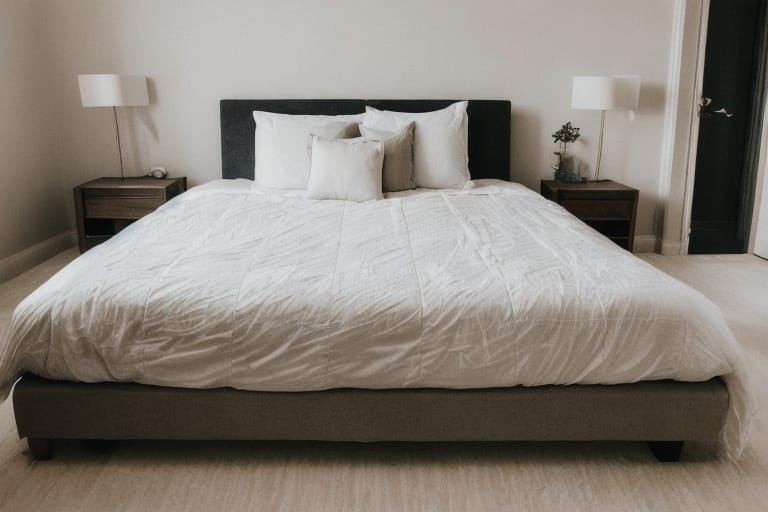
Care and Maintenance Tips
Proper care and maintenance are essential for preserving the fluffiness and integrity of your down comforter.
Proper Fluffing and Loft Restoration Techniques
Regularly fluff your comforter by gently shaking it or placing it in the dryer on low heat with dryer balls. This helps restore loft and redistribute the down evenly.
Washing and Drying Instructions
When washing your down comforter:
- Use a large, front-loading washing machine
- Choose a gentle cycle with cold water
- Use a mild, down-specific detergent
- Dry on low heat with dryer balls
- Ensure the comforter is completely dry before storage
Storage Recommendations
Store your comforter in a breathable cotton bag or covered in a duvet cover to protect it from dust and moisture. Avoid plastic bags, as they can trap moisture and cause the down to deteriorate.
Extending the Lifespan of Your Down Comforter
With proper care, a high-quality down comforter can last 10-15 years or more. Follow the manufacturer’s care instructions and consider professional cleaning when needed.
Top Fluffiest Down Comforter Brands
Several brands are known for their exceptionally fluffy and high-quality down comforters.
Brand Reputations and Customer Reviews
Research brand reputations and read customer reviews to get a sense of the fluffiness, durability, and overall satisfaction associated with different comforters.
Comparison of Leading Luxury Brands
Some popular luxury down comforter brands include:
- Pacific Coast: Known for their high fill power and responsibly sourced down.
- Snowman: Offers lightweight, fluffy comforters with baffle box construction.
- Downlite: Provides a range of hotel-quality down comforters with various fill powers.
Factors to Consider When Choosing a Brand
When selecting a brand, consider factors such as:
- Fill power and down quality
- Certifications for ethical sourcing and quality control
- Construction, including baffle box design or sewn-through stitching
- Brand warranty and return policies
Price Ranges and Value Considerations
Luxury down comforters can range from $200 to $1000+ depending on size, fill power, and brand. Consider your budget and the long-term value of investing in a high-quality comforter that will provide lasting fluffiness and comfort.
Eco-Friendly and Sustainable Options
For environmentally conscious shoppers, there are several eco-friendly and sustainable down comforter options available.
Importance of Ethical and Sustainable Sourcing
Choosing comforters with ethically sourced and sustainable down ensures that the ducks and geese are treated humanely and that the production process has a minimal environmental impact.
Certifications and Standards to Look For
Look for certifications such as the Responsible Down Standard (RDS) or Global Traceable Down Standard (TDS), which ensure that the down is sourced from animals that are not subjected to unnecessary harm.
Recycled and Repurposed Down Options
Some brands offer comforters made with recycled or repurposed down, reducing waste and environmental impact. These options can provide the same fluffiness and quality as virgin down.
Environmental Impact of Down vs. Synthetic
While down is a natural and biodegradable material, synthetic alternatives like polyester or microfiber are derived from petroleum and have a larger carbon footprint. However, some synthetic options are made from recycled materials, reducing their environmental impact.
Lightweight and Breathable Alternatives
For those who prefer a lightweight and breathable comforter, there are several options that maintain fluffiness without excessive warmth.
Benefits of Lightweight Down Comforters
Lightweight down comforters offer the same cloud-like comfort and fluffiness as heavier options, but with better temperature regulation and breathability. They are ideal for hot sleepers or warm climates.
Achieving Warmth Without Excessive Weight
By using high fill power down (800+), lightweight comforters can provide ample warmth without the added weight or bulk of lower fill power options.
Moisture-Wicking and Temperature Regulation
Lightweight down comforters often feature moisture-wicking and breathable shell fabrics that help regulate body temperature and prevent overheating. This ensures a comfortable and restful sleep experience.
Ideal for Hot Sleepers or Warm Climates
If you tend to overheat during the night or live in a warm climate, a lightweight down comforter is an excellent choice. It provides the fluffiness and coziness you crave without trapping excess heat.
All-Season and Year-Round Versatility
Some down comforters are designed for all-season use, offering versatile warmth and fluffiness throughout the year.
Adjusting Warmth Levels for Different Seasons
All-season down comforters often have a moderate fill power and weight, making them suitable for a wide range of temperatures. You can easily adjust the warmth by adding or removing layers, such as blankets or duvet covers.
Layering Options with Duvet Covers
Using a duvet cover with your down comforter allows you to change the style and warmth level seasonally. Choose lighter covers for summer and heavier covers for winter to create a cozy and adaptable sleep environment.
Choosing the Right Tog Rating or Fill Weight
Tog ratings and fill weights can help you determine the warmth level of a comforter. A tog rating of 4-7 is suitable for summer, while 10-13 is ideal for winter. Fill weights can also be adjusted based on your warmth preferences.
Transitioning Between Seasons Seamlessly
With an all-season down comforter, transitioning between seasons is effortless. Simply add or remove layers as needed to maintain your desired level of warmth and comfort.
Duvet Cover Compatibility and Design
A well-chosen duvet cover can enhance the style and functionality of your down comforter.
Importance of Compatible Duvet Cover Sizes
Ensure that your duvet cover is the same size as your comforter, or slightly larger to allow for fluffiness. A too-small cover can compress the down and reduce loft.
Coordinating Colors, Patterns, and Materials
Choose a duvet cover that complements your bedroom decor and personal style. Consider factors such as color, pattern, and material (e.g., cotton, linen, or silk) when making your selection.
Ease of Cover Removal and Cleaning
Look for duvet covers with easy-to-use closures, such as buttons, zippers, or ties, for hassle-free removal and cleaning. Regular washing of your duvet cover helps keep your comforter clean and fresh.
Enhancing Bedroom Decor with Stylish Covers
A stylish duvet cover can serve as a focal point in your bedroom, tying together your decor and creating a cohesive and inviting atmosphere.
Down Comforter Care and Cleaning Services
Proper care and cleaning are essential for maintaining the fluffiness and longevity of your down comforter.
Professional Cleaning and Restoration Services
For thorough cleaning or restoration of an older comforter, consider professional services. Many dry cleaners and specialized bedding companies offer down comforter cleaning and rejuvenation.
Reviving Old or Compressed Down Comforters
If your comforter has become flat or compressed over time, professional restoration services can help revive its fluffiness and loft. This typically involves a deep cleaning process and loft restoration techniques.
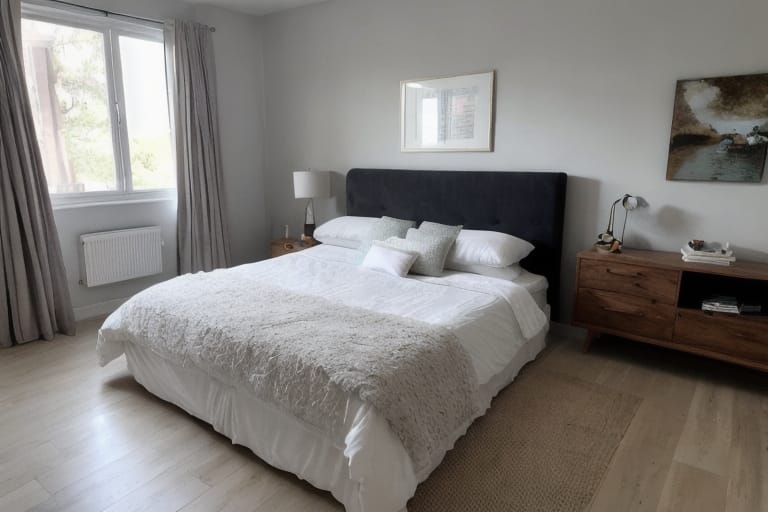
Frequently Asked Questions (FAQs)
- What is the best fill power for a fluffy, luxurious down comforter? For the fluffiest and most luxurious down comforter, look for fill powers of 800 or higher. These comforters offer exceptional loft, insulation, and a cloud-like feel, while remaining lightweight and breathable.
- How do I choose the right warmth level for my down comforter? Consider factors such as your personal preferences, sleeping environment, and the season. Comforters with higher fill powers (800+) provide excellent warmth with less weight, making them ideal for year-round use. You can also look for comforters with specific tog ratings or fill weights to suit your needs.
- Are hypoallergenic down comforters available? Yes, many brands offer hypoallergenic down comforters that undergo special cleaning processes to remove allergens and dust. These comforters provide a clean and comfortable sleeping environment for those with allergies or sensitivities.
- What is the best way to care for and maintain the fluffiness of my down comforter? To maintain your comforter’s fluffiness, regularly fluff it by gently shaking or tumble drying on low heat with dryer balls. Use a mild, down-specific detergent when washing, and ensure the comforter is completely dry before storage. Store your comforter in a breathable cotton bag or duvet cover to protect it from dust and moisture.
- Are there any eco-friendly and sustainable down comforter options? Yes, look for comforters with certifications such as the Responsible Down Standard (RDS) or Global Traceable Down Standard (TDS), which ensure that the down is sourced from humanely treated ducks and geese. Some brands also offer comforters made with recycled or repurposed down, reducing waste and environmental impact.
- Can a down comforter be used year-round, or is it only suitable for colder months? Many down comforters are designed for all-season use, offering versatile warmth and comfort throughout the year. By choosing a comforter with a moderate fill power and weight, you can easily adjust the warmth level by adding or removing layers, such as blankets or duvet covers, to suit your needs in different seasons.
- What should I look for when choosing a duvet cover for my down comforter? When selecting a duvet cover, ensure that it is compatible with your comforter’s size, allowing room for fluffiness. Choose a cover made from breathable, high-quality materials like cotton or linen, and consider factors such as color, pattern, and ease of removal for cleaning. A well-chosen duvet cover can enhance your bedroom decor and protect your fluffy down comforter.

